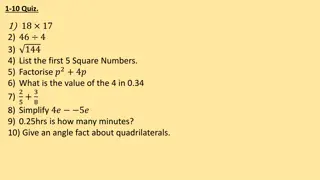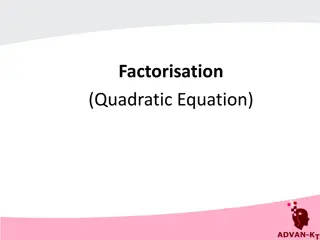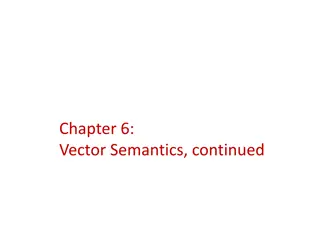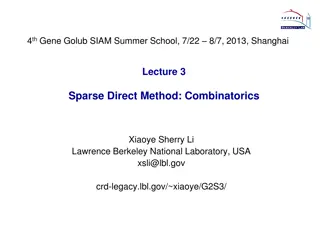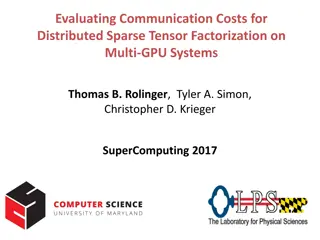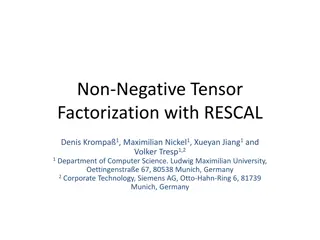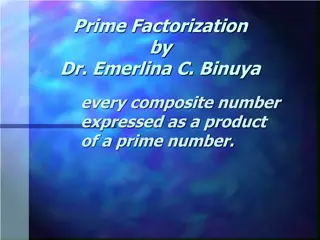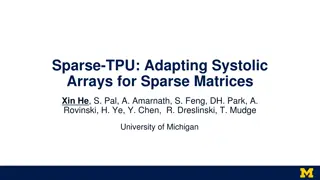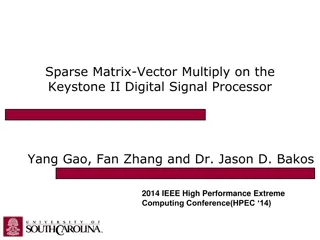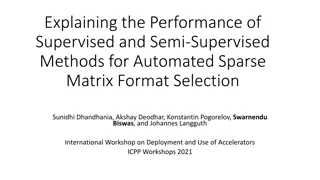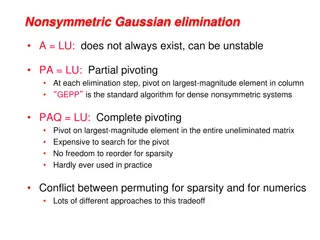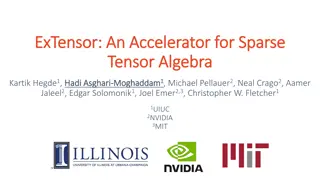Sparse LU Factorization in Electrical Systems Analysis
Exploit the structure of sparse matrices for efficient LU factorization in analyzing large-scale electrical systems. Compare sparse direct solution methods with iterative methods for solving linear systems. Learn about the history of sparse matrices and their development in various disciplines since the 1960s. Understand the computational complexity of solving sparse systems, including forward/backward substitution and diagonal matrices in power system problems.
Download Presentation

Please find below an Image/Link to download the presentation.
The content on the website is provided AS IS for your information and personal use only. It may not be sold, licensed, or shared on other websites without obtaining consent from the author.If you encounter any issues during the download, it is possible that the publisher has removed the file from their server.
You are allowed to download the files provided on this website for personal or commercial use, subject to the condition that they are used lawfully. All files are the property of their respective owners.
The content on the website is provided AS IS for your information and personal use only. It may not be sold, licensed, or shared on other websites without obtaining consent from the author.
E N D
Presentation Transcript
ECE 530 Analysis Techniques for Large-Scale Electrical Systems Lecture 7: Sparse LU Factorization Prof. Hao Zhu Dept. of Electrical and Computer Engineering University of Illinois at Urbana-Champaign haozhu@illinois.edu 9/16/2015 1
Announcements Prof. Tom Overbye will give a special lecture next Monday on power system operations Cecilia will give a tutorial on PowerWorld next Wednesday; you may want to bring your laptop with PW installed Homework 2 due next Wednesday too 2
Solving Sparse Linear Systems We want to exploit sparse matrix structure to reduce computational complexity of LU factorization This type of methods for solving linear systems is termed as sparse direct solution methods An increasingly popular alternative in the numerical analysis community is the group of iterative methods, which iteratively approximates the solution instead of relying on the LU factorization More convenient for parallel computations 3
Sparse Systems For a sparse system, only nonzero elements need to be stored in the computer since no arithmetic operations are performed on the 0 s The triangularization scheme is adapted to solve sparse systems in order to preserve the sparsity as much as possible 4
Sparse Matrix History A nice overview of sparse matrix history is by Iain Duff at http://www.siam.org/meetings/la09/talks/duff.pdf Sparse matrices developed simultaneously in several different disciplines in the early 1960 s with power systems definitely one of the key players (Bill Tinney from BPA) In addition to the 1967 IEEE Proc. paper by Tinney see N. Sato, W.F. Tinney, Techniques for Exploiting the Sparsity of the Network Admittance Matrix, Power App. and Syst., pp 944-950, December 1963 5
Computational Complexity The computational order of factoring a sparse matrix, or doing a forward/backward substitution depends on the matrix structure Full matrix is O(n3); forward/backward substitution is O(n2) A diagonal matrix is O(n); that is, just invert each element For power system problems the classic paper is F. L. Alvarado, Computational complexity in power systems, IEEE Transactions on Power Apparatus and Systems, May/June 1976 O(n1.4) for factoring, O(n1.2) for forward/backward For a 100,000 by 100,000 matrix changes computation for factoring from 1 quadrillion to 10 million! 6
Inverse of A Sparse Matrix The inverse of a sparse matrix is NOT in general a sparse matrix We never (or at least very, very, very seldom) explicitly invert a sparse matrix Individual columns of the inverse of a sparse matrix can be obtained by solving x = A-1b with b set to all zeros except for a single nonzero in the position of the desired column LU factorization has the same complexity O(n3) for a full matrix, but it is much lower for sparse matrix Once obtaining LU factorization, we can solve for the inverse if needed using A-1 = L-1U-1I 7
Scope of Sparse Matrices Sparse matrices arise in many areas, and can have domain specific structures Symmetric matrices Structurally symmetric matrices Tridiagnonal matrices Banded matrices ECE 530 is focused on problems that arise in the electric power; not a general sparse matrix course 8
Computer Architecture Aspects With modern computers the processor speed is many times faster than the time it takes to access data in main memory Some instructions can be processed in parallel Caches are used to provide quicker access to more commonly used data Caches are smaller than main memory Different cache levels are used with the quicker caches, like L1, have faster speeds but smaller sizes; L1 might be 64K, whereas the slower L2 might be 1M Data structures can have a significant impact on sparse matrix computation 9
Full Matrix versus Sparse Matrix Storage Full matrices are easily stored in arrays with just one variable needed to store each value since the value s row and column are implicitly available from its matrix position With sparse matrices two or three elements are needed to store each value The zero values are not explicitly stored The value itself, its row number and its column number Storage can be reduced by storing all the elements in a particular row or column together Because large matrices are often quite sparse, the total storage is still substantially reduced 10
Sparse Matrix Usage Can Determine the Optimal Storage How a sparse matrix is used can determine the best storage scheme to use Row versus column access; does structure change Is the matrix essentially used only once? That is, its structure and values are assumed new each time used Is the matrix structure constant, with its values changed This would be common in the N-R power flow, in which the structure doesn t change each iteration, but its values do Is the matrix structure and values constant, with just the b vector in Ax=b changing Quite common in transient stability solutions 11
Numerical Precision Required numerical precision determines type of variables used to represent numbers Specified as number of bytes, and whether signed or not For Integers One byte is either 0 to 255 or -128 to 127 Two bytes is either smallint (-32,768 to 32,767) or word (0 to 65,536) Four bytes is either Integer (-2,147,483,648 to 2,147,483,647) or Cardinal (0 to 4,294,967,295) This is usually sufficient for power system row/column numbers Eight bytes (Int64) if four bytes is not enough 12
Numerical Precision, cont. For floating point values using choice is between four bytes (single precision) or eight bytes (double precision); extended precision has ten bytes Single precision allows for 6 to 7 significant digits Double precision allows for 15 to 17 significant digits Extended allows for about 18 significant digits More bytes requires more storage Computational impacts depend on the underlying device; on PCs there isn t much impact; GPUs can be 3 to 8 times slower for double precision For most power problems double precision is best 13
General Sparse Matrix Storage Coordinate format: three vectors, each dimensioned to number of elements AA: Stores the values, usually in power system analysis as double precision values (8 bytes) JR: Stores the row number; for power problems usually as an integer (4 bytes) JC: Stores the column number, again as an integer New elements could easily be added, but costly to delete elements An unordered approach is not preferred since elements used next computationally aren t necessarily nearby Usually ordered by row preferred for our methods 14
Coordinate Format Example Assume 5 0 0 0 4 0 0 0 3 4 3 2 = A 4 3 2 10 Then 1 1 2 = = = AA 5 4 4 3 3 2 4 3 2 10 JR 2 3 3 4 4 4 4 JC 1 4 2 4 3 4 1 2 3 4 Note, this example is a symmetric matrix, but the technique is general 15
Compressed Sparse Row Storage If elements are ordered (as was case for previous example) storage can be further reduced by noting we do not need to continually store each row number A common method for storing sparse matrices is known as the Compressed Sparse Row (CSR) format Values are stored row by row Has three vector arrays: AA: Stores the values as before JA: Stores the column index (done by JC in previous example) IA: Stores the pointer to the index of the beginning of each row 16
CSR Format Example Assume as before 5 0 0 0 4 0 0 0 3 4 3 2 = A 4 3 2 10 Then 1 1 2 = = = 2 10 AA 5 4 4 3 3 2 4 3 JA 2 3 3 1 2 3 4 IA 1 3 5 7 17
CSR Comments The CSR format reduces the storage requirements by taking advantage of needing only one element per row The CSR format has good advantages for computation when using cache since (as we shall see) during matrix operations we are often sequentially going through the vectors An alternative approach is Compressed Sparse Column (CSC), which stores the values by column It is difficult to add values using CSR/CSC We ll mostly use the linked list approach here, which makes matrix manipulation simpler 18
Sparse Matrix Storage using Linked Lists A more convenient method is to link up all the entries of a row: easier to insert/delete entries Each linked list has a head pointer that points to the first object in the list For our sparse matrices the head pointer will be a vector of the rows or columns Every object corresponds to a non-zero entry Column a Column c Column b Head Value a Value c Value b Next a Nil Next b 19
Linked Lists by Rows If we have an n by n matrix, setup a class called TSparseElement with fields column, value and next Setup an n-dimensional head pointer vector that points to the first element in each row Each nonzero corresponds to an object of class (type) TSparseElement We do not need to store the row number since it is given by the object s row For power system sparse matrices, which have nonzero diagonals, we also have a header pointer vector that points to the diagonal objects 20
Linked Lists, cont Linked lists can be singly linked, which means they just go in one direction (to the next element), or doubly linked, pointing to both the previous and next elements Mostly we ll just need singly linked lists With linked lists it is quite easy to add new elements to the list. This can be done in sorted order just by going down the list until the desired point is reached, then changing the next pointer for the previous element to the new element, and for the new element to the next element (for a singly linked list) 21
On Board Example Draw the data structures for the matrix 5 0 0 0 4 0 0 0 3 4 3 2 = A 4 3 2 10 22
Example Pascal Code for Writing a Sparse Matrix Procedure TSparMat.SMWriteMatlab(Var ft : Text; variableName : String; digits,rod : Integer; ignoreZero : Boolean; local_MinValue : Double); Var j : Integer; p1 : TMatEle; Begin For j := 1 to n Do Begin p1 := Row(j).Head; While p1 <> nil Do Begin If (not IgnoreZero) or (abs(p1.value) > local_MinValue) Then Begin If variableName <> '' Then Writeln(ft,variableName+'(',(j),',',(p1.col),')=',p1.value:digits:rod,';') Else Writeln(ft,j:5,' ',p1.col:5,' ',p1.value:digits:rod); End; p1 := p1.next; End; End; End; 23
Sparse Working Row Before showing a sparse LU factorization it is useful to introduce the concept of a working row full vector This is because sometimes we need direct access to a particular value in a row The working row approach is to define a vector of dimension n and set all the values to zero We can then load a sparse row into the vector, with computation equal to the number of elements in the row We can then unload the sparse row from the vector by storing the new values in the linked list, and resetting the vector values we changed to zero 24
Loading the Sparse Working Row Procedure TSparMat.LoadSWRbyCol(rowJ : Integer; var SWR : PDVectorList); Var p1 : TMatEle; Begin p1 := rowHead[rowJ]; While p1 <> nil Do Begin SWR[p1.col] := p1.value; p1 := p1.next; End; End; 25
Unloading the Sparse Working Row Procedure TSParMat.UnLoadSWRbyCol(rowJ : Integer; var SWR : PDVectorList); Var p1 : TMatEle; Begin p1 := rowHead[rowJ]; While p1 <> nil Do Begin p1.value := SWR[p1.col]; SWR[p1.col] := 0; p1 := p1.next; End; End; Note, there is no need to explicitly zero out all the elements each iteration since 1) most are still zero and 2) doing so would make it O(n2). The above code efficiently zeros out just the values that have changed. 26
Doing an LU Factorization of a Sparse Matrix with Linked Lists Now we can show how to do an LU factorization of a sparse matrix stored using linked lists We will assume the head pointers are in the vector RowHead, and the diagonals in RowDiag Recall this was the approach for the full matrix For i := 2 to n Do Begin // This is the row being processed For j := 1 to i-1 Do Begin // Rows subtracted from row i A[i,j] = A[i,j]/A[j,j] // This is the scaling For k := j+1 to n Do Begin // Go through each column in i A[i,k] = A[i,k] - A[i,j]*A[j,k] End; End; End; 27
Sparse Factorization Note, if you know about fills, we will get to that shortly; if you don t know don t worry about it yet We ll just be dealing with structurally symmetric matrices (incidence-symmetric) We ll order the row linked lists by column index We will again sequentially go through the rows, starting with row 2, going to row n For i := 2 to n Do Begin // This is the row being processed 28
Sparse Factorization, cont. The next step is to go down row i, up to but not including the diagonal element We ll be modifying the elements in row i, so we need to load them into the working row vector Key sparsity insight: in implementing the below code we only need to consider the non-zeros in A[i,j] For j := 1 to i-1 Do Begin // Rows subtracted from row A[i,j] = A[i,j]/A[j,j] // This is the scaling For k := j+1 to n Do Begin // Go through each column in i A[i,k] = A[i,k] - A[i,j]*A[j,k] End; 29
Sparse Factorization, cont. For i := 1 to n Do Begin // Start at 1, but nothing to do in first row LoadSWRbyCol(i,SWR); // Load Sparse Working Row p2 := rowHead[i] While p2 <> rowDiag[i] Do Begin // This is doing the j loop p1 := rowDiag[p2.col]; SWR[p2.col] := SWR[p2.col] / p1.value; p1 := p1.next; While p1 <> nil Do Begin // Go to the end of the row SWR[p1.col] := SWR[p1.col] - SWR[p2.col] *p1.value; p1 := p1.next; End; p2 := p2.next; End; UnloadSWRByCol(i,SWR); End; 30
Sparse Factorization Example Believe it or not, that is all there is to it! The factorization code itself is quite simple. However, there are a few issues we ll get to in a second. But first an example 5 0 0 0 4 0 0 0 3 4 3 2 = A 4 3 2 10 Notice with this example there is nothing to do with rows 1, 2 and 3 since there is nothing before the diag (p2 will be equal to the diag for the first three rows) 31
Sparse Factorization Example, Cont. Doing factorization with i=4 Row 4 is full so initially p2= A[4,1] // column 1 SWR = [-4 -3 -2 10] p1= A[1,1] SWR[1] = -4/A[1,1] = -4/5 = -0.8 p1 goes to A[1,4] SWR[4] = 10 SWR[p2.col]*p1.value = 10 (-0.8)*-4=6.8 p1 = nil; go to next col p2 =A[4,2] // column 2 P1 = A[2,2] SWR[2] = -3/A[2,2]= -3/4 = -0.75 32
Sparse Factorization Example, Cont. p1 goes to A[2,4] // p2=A[4,2] SWR[4] = 6.8 SWR[p2.col]*p1.value = 6.8 (-0.75)*-3=4.55 p1 = nil; go to next col p2 =A[4,3] // column 3 p1 = A[3,3] SWR[3] = -/A[2,2]= -2/3 = -0.667 p1 goes to A[3,4] // p2 = A[4,3] SWR[4] = 4.55 SWR[p2.col]*p1.value = 4.55 (-0.667)*-2=3.2167 Unload the SWR = [-0.8 -0.75 -0.667 3.2167] p2 = A[4,4] = diag so done 33
Sparse Factorization Examples, Cont. 5 0 0 0 8 0 4 0 0 0 3 4 3 2 = A Factored 0 75 0 6667 . . . . 3 2167 For a second example, again consider the same system, except with the nodes renumbered 10 4 3 2 4 3 2 5 0 0 0 4 0 0 0 3 = B 34
Sparse Factorization Examples, Cont. With i=2, load SWR = [-4 5 0 0] p2 = B[2,1] p1 = B[1,1] SWR[1]=-4/p1.value=-4/10 = -0.4 p1 = B[1,2] SWR[2]=5 (-0.4)*(-4) = 1.6 p1 = B[1,3] SWR[3]= 0 (-0.4)*(-3) = -1.2 p1 = B[1,4] SWR[4]=0 (-0.4)*(-2) = -0.8 p2=p2.next=diag so done UnloadSWR and we have a problem! 10 4 3 2 4 3 2 5 0 0 0 4 0 0 0 3 = B 35
Fills When doing a factorization of a sparse matrix some values that were originally zero can become nonzero during the factorization process These new values are called fills (some call them fill- ins) For a structurally symmetric matrix the fill occurs in a symmetric fashion (i.e., aij and aji) How many fills are required depends on the ordering of rows/columns For a power system case this depends on the bus ordering 36
Fill Examples 4 1 1 2 3 2 3 4 10 4 3 2 5 0 0 0 4 0 0 0 3 4 3 2 4 3 2 5 0 0 0 4 0 0 0 3 = = A B 4 3 2 10 No Fills Required Fills Required (matrix becomes full) 37
Fills There are two key issues associated with fills Adding the fills Ordering the matrix elements (buses in our case) to reduce the number of fills The amount of computation required to factor a sparse matrix depends upon the number of nonzeros in the original matrix, and the number of fills added How the matrix is ordered can have a dramatic impact on the number of fills, and hence the required computation Usually a matrix cannot be ordered to totally eliminate fills 38
7 by 7 Matrix Example Consider the 7 x 7 matrix A with the zero-nonzero pattern shown in (a): of the 49 possible elements there are only 31 that are nonzero If elimination proceeds with the given ordering, all but two of the 18 originally zero entries, will fill in, as seen in (b) 39
Example Matrix Structure rc rc 1 2 3 4 5 6 7 1 2 3 4 5 6 7 X X X X X X X X X X X X 1 1 X X X X X X X X F F X X 2 2 X X X X X X X X F F X X 3 3 X X X X F F X X F F 4 4 X X X X X F F X X X F 5 5 X X X X X X X X F X X F 6 6 X X X X X F F F X 7 7 (a) the original zero- nonzero structure (b) the post- elimination zero-nonzero pattern 40
Example: Reordering We next reorder the rows and the columns of A so as to result in the pattern shown in (c) For this reordering, we obtain no fills, as shown in the table of factors given in (d ) In this way, we preserve the original sparsity of A 41
Example: Reordered Structure rc rc 4 5 1 6 7 3 2 4 5 1 6 7 3 2 X X X 4 X X X 4 X X X X 5 X X X X 5 X X X X X X 1 X X X X X X 1 X X X X X 6 X X X X X 6 X X X 7 X X X 7 X X X X X 3 X X X X X 3 X X X X X 2 X X X X X 2 (d) the post- elimination reordered system (c) the reordered system 42
Fills for Structurally Symmetric Matrices For structurally symmetric matrices we can gain good insights into the problem by examining the graph- theoretic interpretation of the triangularization process This assumption involves essentially no loss in generality since if aij 0 but aji = 0 we simply treat as a nonzero element with the value 0; in this way, we ensure that A has a symmetric structure We term a matrix as structurally symmetric whenever it has a symmetric zero-nonzero pattern 43
Graph Associated with A We make use of graph theoretic notions to develop a practical reordering scheme for sparse systems We associate a graph G with the zero-nonzero structure of the n by n matrix A We construct the graph G associated with the matrix A as follows: i.G has n nodes corresponding to the dimension n of the square matrix: node i represents both the column i and the row i of A; ii. a branch (k, j) connecting nodes k and j exists if and only if the element ajk (and, by structural symmetry, akj) is nonzero; the self loop corresponding to akk is not needed 44
Example: Resistive Network We consider the simple linear resistive network with the topology shown below 1 s 2 s 4 s 3 s 45
Example: Linear Resistive Network The corresponding conductance matrix (or Ybus) has the following zero - nonzero pattern: c 1 2 3 4 r X X 0 X 1 X X X 0 2 0 X X X 3 X 0 X X 4 46
Example: Linear Resistive Network The associated 4-node graph of the matrix is 1 2 4 3 47




